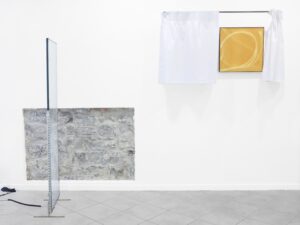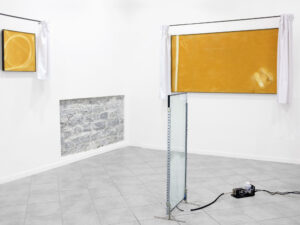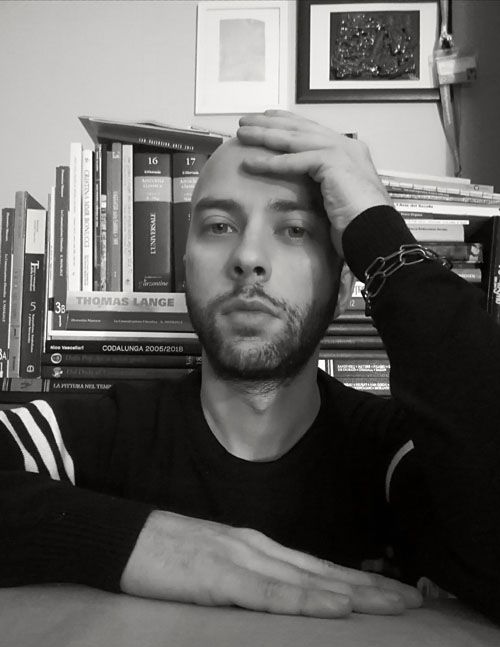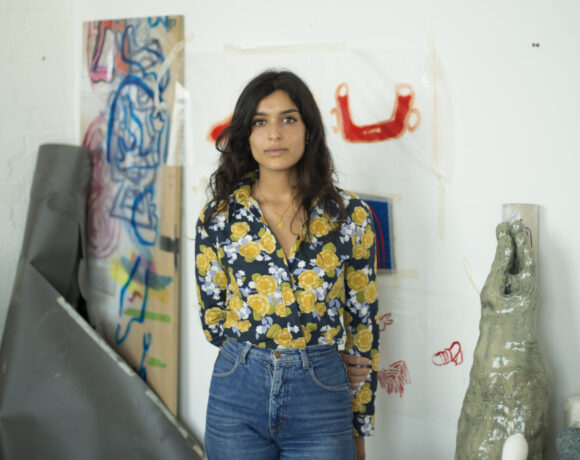Through the double solo show “Nothing to see”, Ramo Gallery, based in Como, renews, in a difficult period like never been before, its commitment to emerging artists. The exhibition builds up a dialogue between Alice Paltrinieri’s latest outcomes and Iacopo Pinelli’s last body of works, authors featured by different backgrounds and languages but who, nevertheless, manifest interesting points of intersection. Now, we can read, thanks to theirs and Simon J. V. David’s words, gallery founder and director, the features of this project.
DS: Simon, what does this exhibition represent for Ramo Gallery, the first opened in 2021, considering all the problems the art world has been facing for more than a year?
SD: Non c’è niente da vedere, (nothing to see), features a series of works specifically created by Alice Paltrinieri and Iacopo Pinelli for the exhibition. As we all know, 2020 was a tough year and 2021 was supposed to kick off more positively, however, as I answer this question I find myself at home not being able to see any of the works exhibited at Galleria Ramo, or of any other exhibitions for that matter. The exhibition was born as an ironic look back at 2020 however, it has become a document of our current situation of not being able to see anything outside of our home /city. On a positive note, the exhibition is viewable online thanks to Artland, social media and our website. Paltrinieri & Pinelli really capture the frustration of a moment in our current history. Hidden behind a wall of smoke, Paltrinieri, explores the space between the void, through a series of sculptures, that block the view of a world beyond a window, focusing our attention on our worldly lock downs and what a future might look post-Covid. While Paltrinieri blocks our view, Pinelli invites you to open a pair of shut curtains, examining the space beyond the void, through series of works which examine time and its flow, bringing us hope for a better future to come.
DS: Moreover, in selecting collaborations with artists, which vision is the gallery following? And, looking forward, what are the intentions for the near future?
SD: I have a deep love for minimalism and I think that it comes across, moreover, I really do believe that in a time of collective disorientation (NFT’s, virtual exhibitions, etc..), research is of the utmost importance for galleries of today. Allowing total freedom, our artists are able to create/exhibit what they want and together finding a thread, a theme which connects us to the works. In a world of deceit, art is truth. “Contemporary” or “Now” art has a special currency today, as a reflection of our society. We currently represent seven artists from all walks of life and originating from America, to South Korea to Italy. I was born in Switzerland, grew up in South Africa and educated in the UK, i am still missing some artists. In other news, we are super exited to share with you, (for the first time publicly) that our next exhibition featuring the works of our two artists: Hyun Cho and Nicolò Masiero Sgrinzatto will open in a new, larger, space, situated just outside the medieval walls of Como.
DS: Alice, what are the features characterizing the works you presented in this exhibition and how do they fit into the your current research direction?
AP: W/smoke is a new project I have decided to present in Galleria Ramo and whose research is still ongoing. It is an artwork aiming to investigate the surrounding space and the relationship getting established between the visitor and the work. The smoke machine is connected to a sensor detecting visitor presence and it releases the smoke inside the glass. It is the person who establishes a relationship of communication with the work and the space, decides how to move and, consequently, how often the smoke gets released, establishing, by this way, an intimate exchange. The glass becomes opaque, stimulating the imagination for new horizons and boundaries. I had already begun to use small engines in my artworks but currently my research is more and more focusing on interaction, connection and space data collection, requiring more specific technologies. The next project I am going to present in May at Spazio Serra, in Milan, will also be focused on the same concept of interaction and registration of space.
DS: Iacopo, on the other hand, what marks your artworks showed in this exhibition and, currently, where is the experimentation leading you?
IP: “Paintings of Sun” art cycle, showed in Ramo Gallery is a series of pictorial works focused on time and its flow. It is an idea born years ago while I was living in Madrid and developed in the context of Marche countryside. On the one hand the warm heat of a metropolis in July, on the other the countryside with its peace and quiet, gave birth to this new working way: a reformulation of natural daily actions as pigmentation by the sun and atmospheric agents on objects and surfaces. The work concerns in placing photosensitive panels and abandoning them to the work of the sun. In the meantime, I carry out normal countryside activities as watering, pruning, hoeing, building, fixing etc. The objects used in these activities, as a water pipe fallen to the ground, boots resting on the threshold of the house, are placed by me on the photosensitive panels, mostly randomly. Everyday gestures that are incessantly repeated like a mantra that is imprinted, stained, marked, engraved and crystallized in the material. Once the time needed for the pigmentation of the panel has passed, the objects get removed and what remains is a play of lights, shadows and bas-reliefs created by the interaction of atmospheric agents and human presence. The outcome is a landscape of memory. Finally, the plates are framed and protected by curtains covering the image, in order not to fade or to lose its lucidity, like a memory it must be protected and preserved. My current research is an analysis of gesture, of its repetition and of the resulting fragments as an outcome of human action. A sort of protection and conservation of daily gestures which, especially in this historical period, leads me to rediscover the real essence of time. I think to be a stubborn experimenter. Every day, and not just for artistic purposes, I investigate everyday life. I learn the essence of trades, I ever change equipment in order to find ever new inputs for my studies and I draw from everyday experiences to transform the experience into a source of inspiration.
DS: Therefore, I ask both artists, how your artworks coexist, in “Nothing to see”?
AP: The impression I have now seeing my artworks and the ones by Iacopo in the same room is, without calculating it, (we didn’t know each other before and each was carrying out these projects even before we met) the whole exhibition appears like a decomposition of a single element, considered by all the meanings that it carries with it. The title that Simon has given to the exhibition already says a lot about the connection established between our works, regarding the prevalence of the ephemeral; they all are focused on a process, they are in constant transformation and this feature opens them towards unknown possibilities, keeping active the relationship with the visitor, who is invited to perform an action (passively or actively) towards every artwork.IP: Me and Alice use certainly different means and techniques to express concepts which are probably similar. Showed artworks coexist according to a relationship I would define unrelated. Glass on one side and curtains on the other, like a breakdown of a unit. What unites the works is the idea of the window which normally performs the function of showing beyond. In “Nothing to see”, the window invites the viewer to look beyond the obstacle. Curtains and glass are the obstacle beyond which the gaze must go and so overcome the block of fears. Only by this way it could be possible appreciate again the world beyond the closures. The title, contrary to its literal meaning, wants to be an invitation not to stop at appearances but to go beyond a cloud of smoke or a closed curtain. The preparation phase was very funny, me ironing the curtains and Alice testing the engines, while the smoke machine fired incessantly into the air. It looked like a mix of a country laundry and a window resale.
Info:
ALICE PALTRINIERI & IACOPO PINELLI. Non c’è niente da vedere
13.02 – 02.05.2021
Galleria Ramo, Via Natta 31, 22110 Como
www.galleriaramo.com






For all the images: Alice Paltrinieri e Iacopo Pinelli. Non c’è niente da vedere. Installation view at Galleria Ramo, Como

Contemporary art critic and curator, he has curated exhibitions in galleries, independent and institutional spaces. He has lectured in Italy and abroad. His texts and research are published in catalogs, sector magazines, gallery editions and monographs. He is the curator of artist archives, contributor to specialized magazines and press offices. He collaborates with foundations, public museums, publishing houses and universities on research and curatorial projects.






NO COMMENT